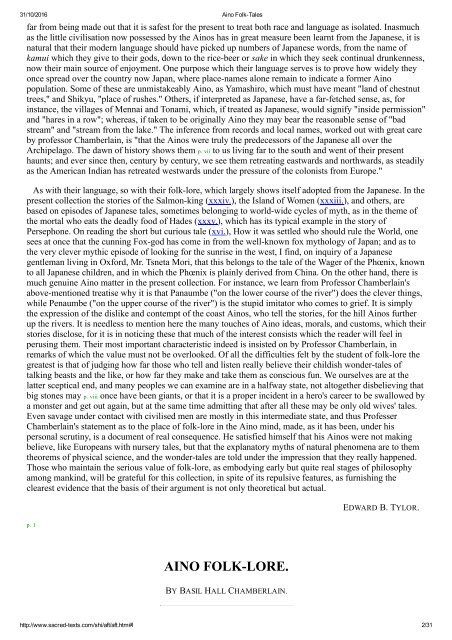Aino Folk-Tales
You also want an ePaper? Increase the reach of your titles
YUMPU automatically turns print PDFs into web optimized ePapers that Google loves.
31/10/2016 <strong>Aino</strong> <strong>Folk</strong><strong>Tales</strong><br />
far from being made out that it is safest for the present to treat both race and language as isolated. Inasmuch<br />
as the little civilisation now possessed by the <strong>Aino</strong>s has in great measure been learnt from the Japanese, it is<br />
natural that their modern language should have picked up numbers of Japanese words, from the name of<br />
kamui which they give to their gods, down to the ricebeer or sake in which they seek continual drunkenness,<br />
now their main source of enjoyment. One purpose which their language serves is to prove how widely they<br />
once spread over the country now Japan, where placenames alone remain to indicate a former <strong>Aino</strong><br />
population. Some of these are unmistakeably <strong>Aino</strong>, as Yamashiro, which must have meant "land of chestnut<br />
trees," and Shikyu, "place of rushes." Others, if interpreted as Japanese, have a farfetched sense, as, for<br />
instance, the villages of Mennai and Tonami, which, if treated as Japanese, would signify "inside permission"<br />
and "hares in a row"; whereas, if taken to be originally <strong>Aino</strong> they may bear the reasonable sense of "bad<br />
stream" and "stream from the lake." The inference from records and local names, worked out with great care<br />
by professor Chamberlain, is "that the <strong>Aino</strong>s were truly the predecessors of the Japanese all over the<br />
Archipelago. The dawn of history shows them p. vii to us living far to the south and went of their present<br />
haunts; and ever since then, century by century, we see them retreating eastwards and northwards, as steadily<br />
as the American Indian has retreated westwards under the pressure of the colonists from Europe."<br />
As with their language, so with their folklore, which largely shows itself adopted from the Japanese. In the<br />
present collection the stories of the Salmonking (xxxiv.), the Island of Women (xxxiii.), and others, are<br />
based on episodes of Japanese tales, sometimes belonging to worldwide cycles of myth, as in the theme of<br />
the mortal who eats the deadly food of Hades (xxxv.), which has its typical example in the story of<br />
Persephone. On reading the short but curious tale (xvi.), How it was settled who should rule the World, one<br />
sees at once that the cunning Foxgod has come in from the wellknown fox mythology of Japan; and as to<br />
the very clever mythic episode of looking for the sunrise in the west, I find, on inquiry of a Japanese<br />
gentleman living in Oxford, Mr. Tsneta Mori, that this belongs to the tale of the Wager of the Phœnix, known<br />
to all Japanese children, and in which the Phœnix is plainly derived from China. On the other hand, there is<br />
much genuine <strong>Aino</strong> matter in the present collection. For instance, we learn from Professor Chamberlain's<br />
abovementioned treatise why it is that Panaumbe ("on the lower course of the river") does the clever things,<br />
while Penaumbe ("on the upper course of the river") is the stupid imitator who comes to grief. It is simply<br />
the expression of the dislike and contempt of the coast <strong>Aino</strong>s, who tell the stories, for the hill <strong>Aino</strong>s further<br />
up the rivers. It is needless to mention here the many touches of <strong>Aino</strong> ideas, morals, and customs, which their<br />
stories disclose, for it is in noticing these that much of the interest consists which the reader will feel in<br />
perusing them. Their most important characteristic indeed is insisted on by Professor Chamberlain, in<br />
remarks of which the value must not be overlooked. Of all the difficulties felt by the student of folklore the<br />
greatest is that of judging how far those who tell and listen really believe their childish wondertales of<br />
talking beasts and the like, or how far they make and take them as conscious fun. We ourselves are at the<br />
latter sceptical end, and many peoples we can examine are in a halfway state, not altogether disbelieving that<br />
big stones may p. viii once have been giants, or that it is a proper incident in a hero's career to be swallowed by<br />
a monster and get out again, but at the same time admitting that after all these may be only old wives' tales.<br />
Even savage under contact with civilised men are mostly in this intermediate state, and thus Professer<br />
Chamberlain's statement as to the place of folklore in the <strong>Aino</strong> mind, made, as it has been, under his<br />
personal scrutiny, is a document of real consequence. He satisfied himself that his <strong>Aino</strong>s were not making<br />
believe, like Europeans with nursery tales, but that the explanatory myths of natural phenomena are to them<br />
theorems of physical science, and the wondertales are told under the impression that they really happened.<br />
Those who maintain the serious value of folklore, as embodying early but quite real stages of philosophy<br />
among mankind, will be grateful for this collection, in spite of its repulsive features, as furnishing the<br />
clearest evidence that the basis of their argument is not only theoretical but actual.<br />
EDWARD B. TYLOR.<br />
p. 1<br />
AINO FOLKLORE.<br />
BY BASIL HALL CHAMBERLAIN.<br />
http://www.sacredtexts.com/shi/aft/aft.htm#I 2/31


